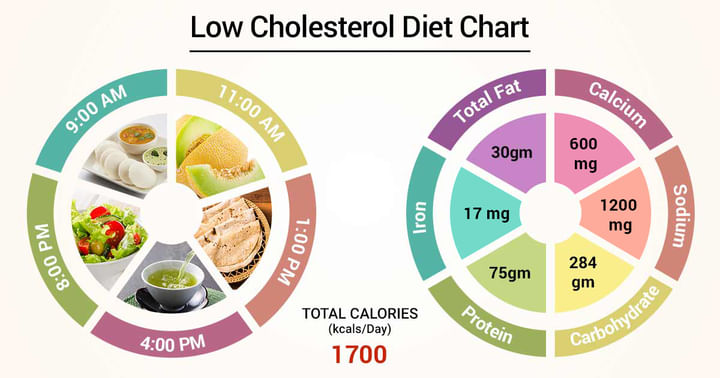Diet Chart For Low Cholesterol
Last Updated: Jan 20, 2025
About
Cholesterol is a waxy, fat-like substance that's found in all the cells in your body. Your body needs some cholesterol to make hormones, vitamin D, and substances that help you digest foods. Your body makes all the cholesterol it needs. Cholesterol is also found in some of the foods you eat. If you have too much cholesterol in your blood, it can combine with other substances in the blood to form plaque. Plaque sticks to the walls of your arteries. This buildup of plaque is known as atherosclerosis. It can lead to coronary artery disease, where your arteries become narrow or even blocked. There are two main types of cholesterol: HDL stands for high-density lipoproteins. It is called the "good" cholesterol because it carries cholesterol from other parts of your body back to your liver. Your liver then removes the cholesterol from your body.
LDL stands for low-density lipoproteins. It is called the "bad" cholesterol because a high LDL level leads to a buildup of cholesterol in your arteries. If you have large deposits of plaque in your arteries, an area of plaque can rupture (break open). This can cause a blood clot to form on the surface of the plaque. If the clot becomes large enough, it can mostly or completely block blood flow in a coronary artery. If the flow of oxygen-rich blood to your heart muscle is reduced or blocked, it can cause angina (chest pain) or a heart attack. Plaque also can build up in other arteries in your body, such as the arteries that bring oxygen-rich blood to your brain and limbs. This can lead to problems such as carotid artery disease, stroke, and peripheral arterial disease.
Cholesterol is in foods that come from animal sources, such as egg yolks, meat, and cheese. Other foods have fats that raise your cholesterol level. For example, saturated fat raises your LDL (bad) cholesterol level more than anything else in your diet. Saturated fat is found in some meats, dairy products, chocolate, baked goods, and deep-fried and processed foods. Another type of fat, trans fats, raise your LDL (bad) cholesterol and lower HDL (good) cholesterol. Trans fats are made when hydrogen is added to vegetable oil to harden it. Trans fats are in some fried and processed foods.
Diet Chart
| Sunday | |
| Breakfast (8:00-8:30AM) | 4 Idly+ 1/2 cup sambhar+1 tsp coconut chutney+1 glass milk/ 1 cup tea |
| Mid-Meal (11:00-11:30AM) | 100gm musk melon |
| Lunch (2:00-2:30PM) | 4 chapathi+1 portion(100gm) grilled/stewed fish+1/2 cup rajmah curry |
| Evening (4:00-4:30PM) | 1/2 cup Sweet potato salad+ 1 cup green tea |
| Dinner (8:00-8:30PM) | 3 chapathi+ 1/2 cup ridge gourd(thori) sabji+1/2 cup vegetable salad |
| Monday | |
| Breakfast (8:00-8:30AM) | 2 paratha(aloo/gobhi/methi) with 2 tsp green chutney |
| Mid-Meal (11:00-11:30AM) | 1 wedge(100gm) watermelon |
| Lunch (2:00-2:30PM) | 1 cup rice+2 chapathi+1/2 cup skin out chicken(100gm) curry+1/2 cup ivy gourd(parmal) sabji+1 glass buttermilk |
| Evening (4:00-4:30PM) | Avocado(50gm) whole wheat bread(3 slices) sandwich+ 1 cup green tea |
| Dinner (8:00-8:30PM) | 3 chapathi(multigrain-wheat;jowar;bajra)+1/2 cup tinda sabji+ 1/2 cup vegetable salad |
| Tuesday | |
| Breakfast (8:00-8:30AM) | 1 cup broken wheat upma with vegetables+1 glass milk/1 cup tea |
| Mid-Meal (11:00-11:30AM) | 1 banana |
| Lunch (2:00-2:30PM) | 1 cup rice+2 chapathi+fish (100gm) curry+cabbage and green peas sabji |
| Evening (4:00-4:30PM) | 1 cup boiled green gram sprouts with lemon+ 1 cup green tea |
| Dinner (8:00-8:30PM) | 3 chapathi+1/2 cup cauliflower sabji+1/2 cup vegetable salad |
| Wednesday | |
| Breakfast (8:00-8:30AM) | 1 cup roasted oats upma with vegetables+1 glass milk/1 cup tea |
| Mid-Meal (11:00-11:30AM) | 100gm pomegranate |
| Lunch (2:00-2:30PM) | 4 chapathi+1/2 cup chana dal+1/2 cup mooli methi sabji+1 glass butter milk |
| Evening (4:00-4:30PM) | 1 cup boiled bengalgram with lemon+ 1 cup green tea |
| Dinner (8:00-8:30PM) | 3 chapathi+ 1/2 cup bhindi sabji+ 1 cup vegetable salad |
| Thursday | |
| Breakfast (8:00-8:30AM) | Vegetable sandwich with 4 whole wheat bread slices+cucumber,tomato, onion,spinach/lettuce |
| Mid-Meal (11:00-11:30AM) | 1 medium size guava |
| Lunch (2:00-2:30PM) | 4 chapathi+1/2 cup cluster beans curry+1/2 cup capsicum sabji+ 1 glass buttermilk |
| Evening (4:00-4:30PM) | 1 small fistful (40 gm) of peanuts,almonds,walnuts+1 cup green tea |
| Dinner (8:00-8:30PM) | 3 chapathi+1/2 cup raw banana sabji+1/2 cup vegetable salad |
| Friday | |
| Breakfast (8:00-8:30AM) | 3 dosa+1/2 cup sambhar+1tsp methi chutney |
| Mid-Meal (11:00-11:30AM) | 1 medium size pear |
| Lunch (2:00-2:30PM) | 1 cup rice+2 chapathi+aloo brinjal sabji+1/2 cup tomato dal+1 glass buttermilk |
| Evening (4:00-4:30PM) | 3 Cracker biscuits+ 1 cup tea/milk(toned) |
| Dinner (8:00-8:30PM) | 3 chapathi(multigrain-wheat;jowar;bajra)+lauki methi sabji+1/2 cup vegetable salad |
| Saturday | |
| Breakfast (8:00-8:30AM) | 1/2 cup Oats in 1 glass milk |
| Mid-Meal (11:00-11:30AM) | 1 medium size apple |
| Lunch (2:00-2:30PM) | 4 chapathi+1/2 cup french beans curry+1/2 cup colocasia(arbi) sabji+ 1 glass buttermilk |
| Evening (4:00-4:30PM) | 1 bowl pop corn+1 cup tea/milk(toned) |
| Dinner (8:00-8:30PM) | 3 chapathi+1/2 cup palak sabji+1/2 cup vegetable salad |
Do's And Dont's
Do's:
- Hydrate yourself with coconut water, soups and other liquids.
- Include green leafy vegetables including cabbage in your diet regularly.
- Consume omega-3 fatty acid rich foods such as fish(trout/salmon/sardine/mackerel/tuna) in stewed form, flax/ chia seeds, almonds, walnuts.
- Do consume vit-c rich foods like oranges, lime, pine apple, berries (strawberry, blueberry, black berry), amla, guava.
Don'ts:
- Avoid sugary foods, junk foods and bakery foods.
- Try not to consume caffeinated and carbonated beverages.
- Avoid alcohol and smoking.
- Avoid processed and frozen foods.
- Avoid oily and fatty foods and meats, red meat, spicy foods.
Food Items You Can Easily Consume
- Cereal: Brown rice, whole wheat, oats, jowar, bajra, ragi
- Pulses: red gram, green gram, black gram, bengal gram
- Vegetables: all gourds-bitter gourd, snake gourd, ridge gourd, bottle gourd, ivy gourd, ladies finger, tinda,green leafy vegetables
- Fruits: banana, citrus fruits-orange, mousambi, grape fruit, lemon; berries-strawberry, blueberry, black berry; cranberry, cherries, papaya, pineapple, avocado, guava.
- Milk and milk products: low fat milk, low fat curd, low fat paneer.
- Meat,fish & egg: Skin out chicken, egg white, fish like salmon, sardines, trout, mackerel, tuna.
- Oil: 2 tsp (10ml)
- Sugar: 2 tsp (10gm)
- Other beverages: green tea.
References
- Woodhill JM, Palmer AJ, Leelarthaepin B, McGilchrist C, Blacket RB. Low fat, low cholesterol diet in secondary prevention of coronary heart disease. InDrugs, Lipid Metabolism, and Atherosclerosis 1978 (pp. 317-330). Springer, Boston, MA. [Cited 23 March 2020]. Available from:
- Rosenthal MB, Barnard RJ, Rose DP, Inkeles S, Hall J, Pritikin N. Effects of a high-complex-carbohydrate, low-fat, low-cholesterol diet on levels of serum lipids and estradiol. The American journal of medicine. 1985 Jan 1;78(1):23-7. [Cited 23 March 2020]. Available from:
- Friedman G, Goldberg SJ. An evaluation of the safety of a low-saturated-fat, low-cholesterol diet beginning in infancy. Pediatrics. 1976 Nov 1;58(5):655-7. [Cited 23 March 2020]. Available from:
Table of content
Find Dietitian/Nutritionist near me
Ask a free question
Get FREE multiple opinions from Doctors



